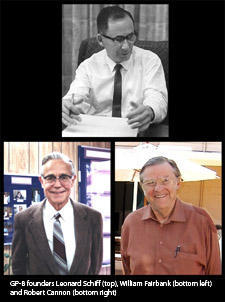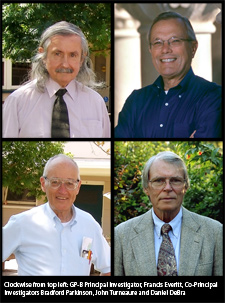About Us
On this page:
A Brief Overview of Gravity Probe B
The idea of testing general relativity by means of orbiting gyroscopes was suggested independently in late 1959-early 1960 by Stanford physicist Leonard Schiff and MIT physicist George Pugh. Pugh’s Proposal for a Satellite Test of the Coriolis Prediction of General Relativity appeared in an unusual location for scientific papers: the U.S. Department of Defense Weapons Systems Evaluation Group (WSEG) Memo #11 (November, 12, 1959). Schiff, then chairman of the Stanford University Physics Department, published a paper summarizing the experiment, Possible New Experimental Test of General Relativity Theory in the March 1, 1960 issue of Physical Review Letters. Also during this time, Schiff teamed up with two colleagues from the Stanford faculty: low-temperature physicist William Fairbank and gyroscope expert Robert Cannon of the Department of Aeronautics & Astronautics. Thus was born the collaboration between the Stanford Physics and Engineering departments that has been essential to the success of Gravity Probe B.
In 1962, Francis Everitt was invited to Stanford as the first full-time academic staff member on the experiment. NASA’s Office of Space Sciences, under the leadership of Dr. Nancy Roman, provided research funding in 1964, with Fairbank and Cannon as Co-Principal Investigators and Schiff as Program Advisor. In 1971, program management was transferred to NASA’s Marshall Space Flight Center (MSFC) in Huntsville, AL. By 1981, Francis Everitt had become the single person most knowledgeable about all aspects of the GP-B experiment. For this reason, he was promoted to the job of Principal Investigator, challenged with bringing the experiment to fruition—a job that would ultimately take another 25 years to accomplish.
On April 20, 2004, the GP-B spacecraft finally launched from Vandenberg Air Force Base on the central California Coast. Iniialization and on-orbit checkout of all spacecraft systems and the science instrument lasted four months, culminating with the spin-up and alignment of the four science gyroscopes in August 2004. Science data collection commenced in September 2004 and lasted 50 weeks. This was followed by a series of planned, post-science instrument calibration tests which lasted until the last of the liquid helium cryogen in the spacecraft's dewar was exhausted, which occurred on September 29, 2005. Since that time, data analysis has been proceeding, as the GP-B science team has worked through two unexpected complications in the data. Preliminary results were announced in April 2007, at the annual meeting of the American Physical Society in Jacksonville, FL. As of August 2008, the data analysis is nearing completion. Another progress update on the results is expected to be announced in October 2008 at a relativity conference in Switzerland. It is expected that the data anlaysis will be concluded and final results announced early in 2010.
For a complete and detailed overview of the GP-B experiment and mission, including the history and management, launch and on-orbit operations, data collection, processing and analysis and the greater legacy of GP-B, see the Mission Tab of this Web site.
About this Web Site
The current version of the GP-B Web—the second revision since its debut in 1995—was conceived and designed jointly by Bob Kahn (GP-B Pulic Affairs Coordinator), Shannon Range (GP-B Education & Public Outreach Coordinator) and Jennifer Spencer (Science Data Processing Manager and former GP-B Webmaster). Theoretical Physicist, James Overduin, provided the contents of the Spacetime Tab and other science content consulting. Technical consulting, including style sheets, scripting and design implementation, was provided by Brian Young (Web Design & Development Group, Stanford Information Technology Services).
You can read more about the philosophy and evolution of this Web site in the Spring 2008 Mission News story.
If you have questions, comments or issues with this Web site, please send an email message to the GP-B Webmaster.


